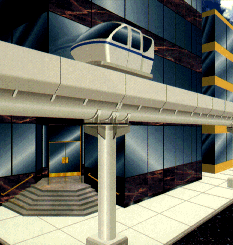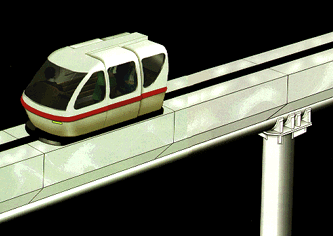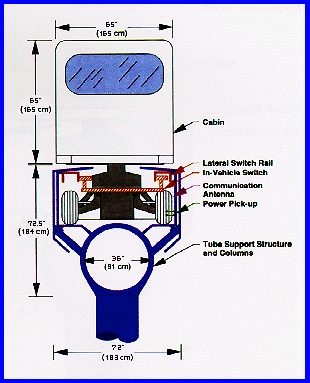

Sections of the following are taken from the paper "Design and Commercialization of the PRT 2000 Personal Rapid Transit System" by S.J.Gluck, R.Tauber, B.Schupp, and J.E.Anderson. Graphics and system data courtesy Raytheon Company.
The System
The Raytheon Company's PRT 2000 transportation system grew out of over a decade of
systematic analysis of the problems of contemporary urban transportation, involvement in a
variety of transit planning studies, study of characteristics of new systems required to
solve these problems, study of how these systems might fail and how to make the design
fault tolerant and fail safe, study of over 46 categories of tradeoffs or design choices,
development of long lists of design criteria, and engineering analysis of each tradeoff to
determine the best choice. The requirement for cost-effectiveness -- to so reduce costs
and increase service that the system could be built and operated at a profit - was a
primary goal.
A brief summary of key features is as follows: An exclusive guideway is required to safely attain high average speeds and must be small to minimize cost and obtrusiveness. Because the cost of transit vehicles per unit of capacity (or per place) is independent of vehicle size, the cost of the fleet, regardless of vehicle size, is minimized if the average trip speed is maximized. The average speed is maximized if all intermediate stops are eliminated - possible if all stops are on bypass tracks off the main line and practical if the smallest size vehicles are used. Fortunately, dynamic structural analysis shows that the weight of the guideway is reduced to a much lower value than might be expected if the smallest size vehicles are used, down by a factor of 15 from conventional elevated rail systems. To minimize cost, the vehicles have to be small enough so that they can be used by small parties of people traveling together by choice.
The nonstop trip is made possible by use of off-line stations. Ridership is maximized if these stations are closely spaced in a network of interconnected guideways that eliminate the need for passengers to transfer from line to line. Such features require safe, reliable, rapid switching, realized by 1) use of a new in-vehicle switch having no moving track parts, 2) automatic control, 3) appropriate switching logic, and 4) electronic communication. A new and comprehensive method of determining the reliability required of all subsystems, which quantified the advantages of redundancy and failure monitoring, gave confidence that a very reliable system could be built if certain design choices were made.

PRT 2000 system utilizes an elevated guideway design.
Analysis of operating and maintenance costs per passenger-km showed that these costs are minimized if operation is strictly on demand and if empty vehicles are rerouted by a central computer from stations with excess vehicles to stations with shortages. To minimize costs, vehicles must wait at each off-line station for passengers or freight, moving only if travel is required. This is unlike conventional bus and rail transit in which vehicles must move on a schedule independent of fluctuations in passenger demand, this forcing passengers to wait for vehicles.
To permit operation at the closest practical headways in all weather conditions, PRT 2000 uses a combination of electric motor propulsion and microprocessor control, not available a decade ago in the small size and low weight required. Such features provide high capacity safely and reliably with minimum noise and air pollution. It uses a unique guideway configuration that meets over 30 criteria obtained by analyzing and planning these systems. PRT 2000 is built of available technology, proven during the past two decades in industrial, military and automated transit applications.
The steel guideways of PRT 2000 are lightweight. To increase the natural frequency in bending and torsion, they are rigidly bolted to support posts. Expansion joints are included and stiff steel running surfaces are overlapped and adjusted to provide a smooth ride. Guideway covers aid winter operation, provide electromagnetic shielding, reduce lateral air drag, and permit the color and texture of the external surface to complement the cityscape. The elevated configuration reduces the land devoted to transit to that needed for posts and stations. PRT 2000 is easy to erect, easy to expand, and easy to move. The electric motors and high-pressure tires running on steel rails all but eliminate the air pollution, noise and vibration associated with conventional transport.

PRT 2000 vehicle and guideway design.
At each station, a map of the system of lines and station is posted near a ticket machine similar to a bank cash machine. A patron selects a destination on the network, whereupon a display verifies the destination and indicates the fare, which may be paid by cash, a prepaid card, or a credit card. The machine then dispenses a ticket on which the destination is magnetically encoded. The patron takes the ticket to the loading platform and inserts it into a slot in a stanchion in front of the first empty vehicle in a line of usually three or four vehicles, like a sheltered taxi stand. The ticket is read and the destination is transferred to a microprocessor aboard the vehicle. The door then opens, the patron, or a group of two to four patrons traveling together, enter, sit down and the door is closed. This action informs the vehicle microprocessor that the vehicle is ready to go. A wayside computer senses an opening, the vehicle accelerates and merges into the stream of traffic that is by-passing the station, and proceeds nonstop to the planned destination.
The result of system optimization for minimum life-cycle cost is a breakthrough. Detailed cost estimates, repeated in successive stages over a period of six years, show that in many reasonable applications, PRT 2000 can be built and operated at far lower cost than existing rail transit modes. The result is also energy minimization -- the combination of nonstop travel and lightweight, streamlined vehicles more than doubles energy efficiency.
The remarkable result of cost minimization is a humanizing technology. PRT 2000 requires vehicles to wait for people rather than people to wait for vehicles. It provides a short, predictable, nonstop trip on a network of guideways, a seat for everyone, climate control, no transfers, minimum or no wait, 24 hour on-demand service, ease of use, privacy, no crowding, space for luggage, no jerky motion, no objectionable sounds, no smelly fumes, minimum anxiety, maximum safety, minimum land use, and minimum disruption to businesses and the community while the system is installed. PRT requires no turnstiles, which are barriers to the handicapped, and provides mobility for all, including those who are unable to drive. The system can also carry mail, groceries, luggage, household goods, appliances and furniture.
The appearance of PRT 2000 is unobtrusive. As compared to other transit modes, little space is needed for guideways. As surface traffic is reduced, existing streets can be partly turned into linear parks and gardens, bringing to the city a balance with nature enticing to all. PRT 2000 does for horizontal development what the elevator did for vertical development. Study of factors that induce people to ride transit suggest that disappointing ridership on present people movers using conventional transit service concepts bears no relationship to the potential ridership on a PRT 2000 system.
To see information on similar technologies, see the PRT overview page
![]()
Last modified: August 18, 2002